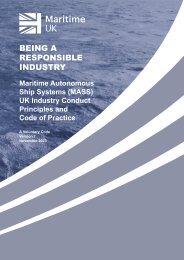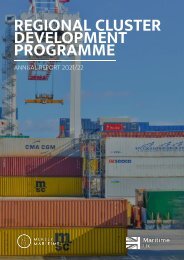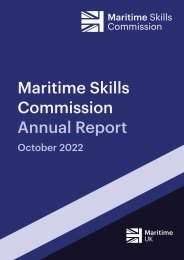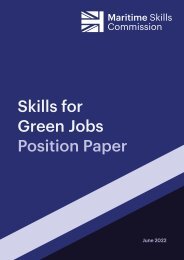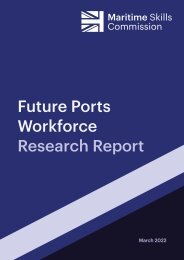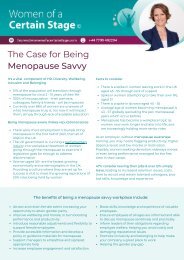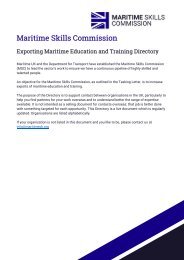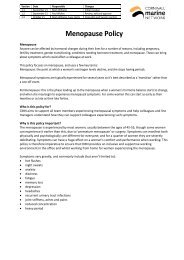Maritime Skills Commission - Labour Market Intelligence Scoping Report - August 2020
Create successful ePaper yourself
Turn your PDF publications into a flip-book with our unique Google optimized e-Paper software.
<strong>Labour</strong> <strong>Market</strong> <strong>Intelligence</strong> <strong>Report</strong> - 30<br />
Here we focus solely on the <strong>Maritime</strong> Sector on a holistic<br />
basis; a full description of how the direct, aggregate and<br />
regional economic impacts of each industry has been<br />
measured can be found in Cebr’s separate reports for<br />
each industry.<br />
Quantifying the direct economic impacts of the <strong>Maritime</strong><br />
Sector and data sources<br />
The first stage of the study, discussed in more detail in<br />
Cebr’s separate reports on the shipping, ports, leisure<br />
marine, marine engineering and scientific and <strong>Maritime</strong><br />
Business Services industries, has involved mapping the<br />
activities of each industry against the National Accounts<br />
framework, in order to establish clarity on the precise<br />
definition of activities as they map against the Standard<br />
Industrial Classification (SIC) framework.<br />
In essence therefore, this involves taking each of the<br />
sector’s and industry’s activities, and mapping these to the<br />
most relevant Standard Industrial Classification (SIC) code<br />
in order to identify the activity’s economic data. It is clear<br />
from Cebr’s analysis that the majority of activities do map<br />
neatly onto the National Accounts framework. As a result,<br />
Cebr have been able to exploit company financials data<br />
in addition to publicly-available data sources such as the<br />
Annual Business Survey to gather data for some constituent<br />
activities of the sector. Cebr has therefore drawn upon a<br />
combination of publicly-available data, desk research and<br />
industry data to quantify the economic contribution from the<br />
<strong>Maritime</strong> Sector.<br />
In order to quantify the direct economic impacts of the<br />
<strong>Maritime</strong> Sector, a number of different approaches have<br />
been taken which reflect the degree of alignment (or<br />
otherwise) for each activity against the National Accounts<br />
framework. They are as follows:<br />
The major source of data used to quantify the direct<br />
economic contribution of the <strong>Maritime</strong> Sector is the<br />
Financial Accounts Made Easy (FAME) database, which<br />
provides business demography and financial accounts<br />
data for companies operating in the UK <strong>Maritime</strong><br />
Sector. The FAME database has been used to generate<br />
estimates for the business turnover, GVA, employment,<br />
the compensation of employees and profitability of the<br />
shipping industry.<br />
For those industries and constituent activities which do<br />
not map neatly against the national accounts framework,<br />
a combination of industry sources (such as the British<br />
Marine Key Performance Indicators) and publiclyavailable<br />
data sources have been used to generate direct<br />
economic impact estimates.<br />
As FAME does not provide data on exports of goods and<br />
services, data have instead been sourced from both the<br />
ONS Pink Book or industry sources such as the UK<br />
Chamber of Shipping’s (UKCoS) Annual Sea Inquiry. In<br />
some instance the ONS Supply Use Tables have been<br />
used to generate estimates.<br />
Data for the direct economic contribution of each<br />
industry have by extension been then used to quantify<br />
the contribution that the <strong>Maritime</strong> Sector makes to the<br />
UK Exchequer, and the productivity of the sector in terms<br />
of GVA per job.<br />
Again, a more detailed description of sources used for<br />
each industry and their constituent activities can be found<br />
in Cebr’s separate industry reports, which quantify the<br />
economic contribution of each industry.<br />
5.4 In discussion, CEBR explained that they had to<br />
do a good deal to supplement and complement<br />
the data available through the Standard Industrial<br />
Classification (SIC) codes; the result is, in their<br />
words, “highly bespoke”.<br />
5.5 Two examples illustrate that tailoring:<br />
Cebr sense-checked their emerging conclusions<br />
with sector insiders at different stages,<br />
typically exploring whether individual companies




